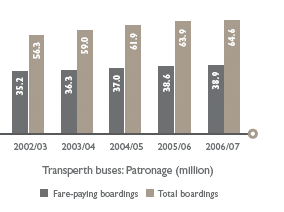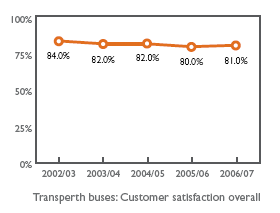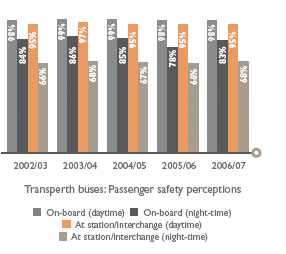TRANSPERTH BUSES
DESCRIPTION OF SERVICES
During 2006/07, the Transperth bus system operated 320 standard timetabled bus routes and 436 school routes. On a typical weekday this involved operating 9,327 standard services and 436 school services. Accessible buses are always used on 55 of the standard routes. A bus service frequency of 20 minutes or better is provided all day on most major corridors, with higher frequencies in peak periods.
Transperth bus services were operated by three contractors under 11 contracts in 2006/07:
- Path Transit (Marmion-Wanneroo and Morley contracts, with the Joondalup Central Area Transit contract forming part of the Morley contract).
- Swan Transit (Canning, Kalamunda, Midland, Southern River, Claremont, and Belmont contracts).
- Southern Coast Transit (Rockingham, Fremantle-Cockburn, and Perth Central Area Transit contracts, with the Fremantle Central Area Transit contract forming part of the Fremantle-Cockburn contract).
The Midland contract was re-tendered and awarded to Swan Transit with effect from 27 January 2007. The auditing of each of Transperth’s bus contractor's safety management systems continued during the year to ensure that they met AS 4901 – OSH Management Systems.
THE YEAR’S DEVELOPMENTS
As part of planning for the introduction of Southern Suburbs Railway, Transperth carried out a comprehensive review of the bus route network throughout the southern corridor and parts of the south-eastern corridor of Perth with a view to modifying the bus route network to integrate it with the new train line. A conceptual bus route network was developed, identifying service levels and frequencies, using principles successfully established for the northern suburbs bus network.
Feedback on the proposed changes was an important stage in the planning process to ensure that the proposed bus network met community needs. The consultation process began with 22 meetings held with key stakeholders followed by broader community engagement. The community consultation process was centred on a series of public displays at key locations throughout the southern corridor and parts of the south-eastern corridor. In addition a consultation webpage was developed on the Transperth website, outlining proposed changes to the bus route network and providing an avenue for feedback via an online form.
The consultation process for the southern suburbs bus network was the largest ever carried out by Transperth with over 2,600 people attending 32 community displays. Amendments were made to the conceptual bus route network based on community feedback.
In December 2006, Transperth bus services in the Kwinana/Cockburn area were relocated from the temporary bus station facility at Gateway Shopping Centre to the new Cockburn Central bus/train interchange. The temporary facility at the shopping centre, which had operated since 1999, had provided a public transport hub allowing passengers using feeder services to access the main line service operating along the Kwinana Freeway to Perth.
The new bus station, which is the bus component
of the future Cockburn Central train/bus
interchange,
![]() will provide bus services to the area
until the Southern Suburbs Railway opens and the
network of feeder services commences.
will provide bus services to the area
until the Southern Suburbs Railway opens and the
network of feeder services commences.
Total service kilometres operated by the Transperth bus network continued to increase. In 2006/07, the network covered 49.961 million kilometres, an increase of 1.7% over the 49.146 million kilometres recorded in 2005/06, which was itself an increase of 1.2% compared with the previous year.
Total capacity provided by the bus network increased for the second year with 3,592.5 million passenger place kilometres being provided in 2006/07 compared with 3,559.8 million passenger place kilometres in 2005/06, an increase of 0.9%, following the increase of 0.4% in the previous year.
The lower rate of increase in passenger place kilometres compared with the rate of increase in service kilometres is due to the increasing proportion of Compressed Natural Gas (CNG) buses in the fleet which have a slightly lower average carrying capacity compared with diesel buses.
At 30 June 2007, Transperth operated 293 gaspowered buses in its fleet of 1,114 buses. A further 306 new gas buses are due to be delivered by June 2011 under the existing Bus Supply Agreement. In December 2006, a permanent CNG refuelling facility at Fremantle depot began operations, replacing the temporary facility that had been in service since May 2005. CNG refuelling operations commenced at Rockingham bus depot in June 2007. The laying of a high pressure pipeline for the Welshpool bus depot CNG facility commenced during the year. This facility is scheduled to be commissioned in April 2008.
Inspections were carried out at depots with CNG capability to identity the work required to ensure the workshops met all occupational safety and health standards that meet AS2746 – “Working areas for gas fuelled vehicles”.
COST OF THE SERVICE
The total cost of operating Transperth bus services increased by 1.1% from $251.2 million in 2005/06 to $254.0 million. Operating expenditure increased from $195.8 million to $205.3 million, i.e. by 4.8%.
The increase in operating costs was primarily driven by increases in the cost of fuel, labour and security.
PATRONAGE
Patronage continued to grow on Transperth’s bus services in 2006/07 although at a lower rate of increase.
Fare-paying boardings increased from 38.650 million in 2005/06 to 38.886 million in 2006/07, i.e. by 0.6%. This compares with an increase of 4.5% in 2005/06. Total boardings recorded an increase of 1.1% from 63.891 million in 2005/06 to 64.623 million in 2006/07.
The decline in the rate of growth in bus fare-paying boardings was due to a combination of factors – the loss of the Kwinana Freeway busway during most of 2006/07, increasing traffic congestion in peak periods, the lack of bus priority measures on major roads resulting in non-competitive travel times and the low rate of increase in service kilometres over the past few years.

These factors had a major impact on total fare-paying boardings in the southern contract areas, where boardings fell by 1.2% overall, due to a 2.0% decline in Fremantle-Cockburn and no change in the Rockingham-Mandurah contract area. A similar impact was felt in the Canning contract area in 2005/06 when fare-paying boardings fell by 1.9% but this area saw some stabilisation of patronage during 2006/07.
Bus patronage in the northern suburbs was affected by provision of additional parking bays following the opening of train stations at Clarkson in October 2004 and Greenwood in January 2005.
A total of 786 parking bays were provided at Clarkson and 609 at Greenwood, which gave more people in the northern suburbs the opportunity to travel by train without using feeder buses, that is by using the increased Park ‘n’ Ride facilities. The additional parking bays were quickly taken up, resulting in increased fare-paying boardings on trains but with a commensurate drop on buses. This contributed to the containment of growth in bus boardings in the northern suburbs, with an increase of 1.9% in 2006/07 compared with 3.5% in 2005/06.
Boardings on the Circle Route also fell in 2006/07. While this popular service has generally enjoyed high rates of growth in previous years (e.g. 6.5% in 2005/06), there is an indication that delayed buses and a marginal increase in journey times due to increasing traffic congestion are affecting patronage, particularly in peak periods on major roads such as South Street and Stirling Highway. This was reflected in the 0.7% decline in fare-paying boardings recorded in 2006/07.
The most positive growth area for fare-paying boardings on the Transperth bus network was the Claremont and Belmont contract areas which showed an increase of 4.8% in 2006/07 following an increase of 6.1% in 2005/06. These contract areas are seeing the accrued benefit of actions some years before, whereby route rationalisation has resulted in more direct routes and reduced journey times. However, the challenge of traffic congestion is likely to impact on these inner city contract areas in coming years unless improved bus priority can be established at “pinch points”.
The rate of growth in bus service kilometres over the past five years has been limited. Overall, between 2002/03 and 2006/07, bus service kilometres increased by 4.6%. Service kilometres increased by 1.7% in 2006/07 following an increase on 1.2% in 2005/06.
Average boardings on buses declined in 2006/07 due to service kilometres increasing at a higher rate than patronage (1.7% compared with 0.6%). Fare-paying boardings per service kilometre which had reached 0.786 in 2005/06 declined to 0.778 in 2006/07 (1.0%), while total boardings per service kilometre fell from 1.300 to 1.293 (0.5%), between 2005/06 and 2006/07.
PASSENGER SATISFACTION
The Transperth Passenger Satisfaction Monitor 2007 showed that the proportion of bus users who were satisfied with the bus system overall increased to 81% from 80% in 2006.
Passenger rating of characteristics of Transperth bus services
SERVICE CHARACTERISTIC | IMPORTANCE RATING | SATISFACTION RATING | ||
| 2006 | 2007 | 2006 | 2007 | |
| Cost of fares | 62% | 65% | 72% (6%) | 70% (9%) |
| Punctuality of the bus | 73% | 64% | 79% (10%) | 76% (12%) |
| Number of buses on weekdays | 66% | 63% | 71% (18%) | 72% (17%) |
| Speed of the trip | 54% | 62% | 85% (6%) | 84% (7%) |
| Cleanliness on board | 53% | 59% | 87% (4%) | 89% (3%) |
| Driver’s manner | 54% | 55% | 89% (2%) | 90% (2%) |
| Driver’s handling of the bus | 55% | 53% | 89% (3%) | 90% (4%) |
| Number of buses during peak times | – | 47% | – | 75% (15%) |
Note: Dissatisfaction level shown in parenthesis.
The table shows that there was a significant level of dissatisfaction with the number of buses on weekdays (17%) punctuality of services (12%), and the cost of fares (9%).

The importance rating of the service characteristics of Transperth’s bus services (other than passenger safety – see table above) and the level of satisfaction for each key service characteristic are shown.
PASSENGER SAFETY
In the Passenger Satisfaction Monitor, bus users were asked: “How safe do you generally feel from personal interference or threat from other passengers …?”
The graph shows the proportion of respondents who “always or usually feel safe” at the specified times/locations on the bus network.
The results for the past five years show that almost all bus passengers generally felt safe on-board buses and at station/interchanges during the day.

It is noteworthy that there was a significant increase in the proportion of respondents who generally felt safe on-board buses at night to 83% from 78% in 2006. The proportion of respondents who felt generally safe at night at the station/ interchanges also increased, although at a lower rate from 66% to 68%.
Over recent years, Transperth has introduced the following measures to promote passenger safety on the bus network:
- Two security officers are deployed Monday to Saturday each week at each major bus station between 7am and the last bus.
- Mobile patrols are deployed on each of the three major sectors – north, south and east – on busy nights of the week.
- There is centrally monitored CCTV at all bus stations.
- CCTV has been installed on new buses in the fleet.
PLANNED MAJOR INITIATIVES FOR 2007/08
- Implementation of the SSR bus feeder network
- Acquisition of a further 72 new CNG buses for the bus fleet
- Completion of works to ensure that all CNG workshops achieve the standard required to meet AS2746 – “Working Areas for Gas Fuelled Vehicles”.



